Written by Hannah Hazelbaker
Did you know that whale sharks (Rhincodon typus) are related to nurse sharks? Or that a group of scientists chased a whale shark down and gave it an ultrasound? Read on for a bunch of facts about whale sharks you may not have known! We’re answering some of the most common questions and peppering in some surprising info.
Why are whale sharks so big?
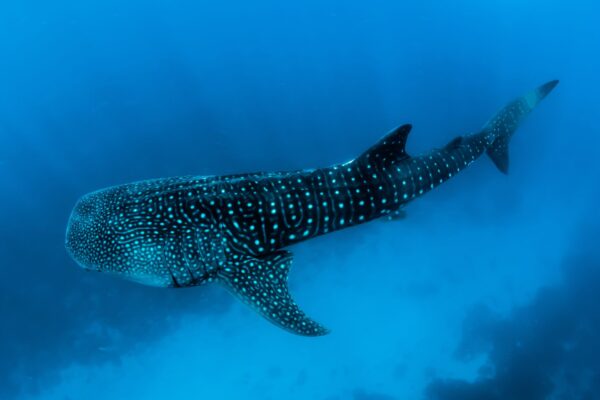
Fun fact about whale sharks: their colors are leftover from their ancestors, the carpet sharks. ⏐ Photo by Sebastian Pena Lambarri on Unsplash
Whale sharks are big so they stay warm. Have you ever wondered why some of the biggest animals on the planet are herbivores or filter feeders— not carnivores? There are a few reasons, but when it comes to whale sharks, it’s all about heat conservation.
One fact about whale sharks is that unlike great whites or makos, whale sharks are ectothermic— they don’t produce their own body heat. You could say they’re cold blooded, but that’d be asking every scientist in a five-mile radius for a lecture on why you shouldn’t use the term “cold blooded.”
Whale sharks lose body heat as they feed in cool, deep water. They return to the warm, shallow surface to heat up again before heading back down. Large objects tend to lose heat slower than small ones. So the bigger you are, the more heat you have, and the longer you can feed at depth (source)⁴. Then the more you eat, the bigger you can get, and you can eat for longer later on. If you ask any whale shark, this is a great way to pass the time.
Another fun fact about whale sharks is that they are negatively buoyant (source)⁶. This means they naturally sink. All sharks control their buoyancy with the help of their liver. It’s full of an oil called squalene that’s lighter than water. Whale sharks have a liver-to-body ratio that’s smaller than other sharks (source)². They conserve energy by sinking down to their feeding grounds instead of actively swimming there (source)³.
How do whale sharks protect their eyes?
One fact about whale sharks is that they have dermal denticles on their eyeballs (yes, on). Dermal denticles are a shark’s version of fish scales. Think of how fast you can swim through water. If you did swimming in high school, then maybe you’re pretty quick, but even the slowest shark could defeat you in a varsity tournament. One reason for that is their dermal denticles.
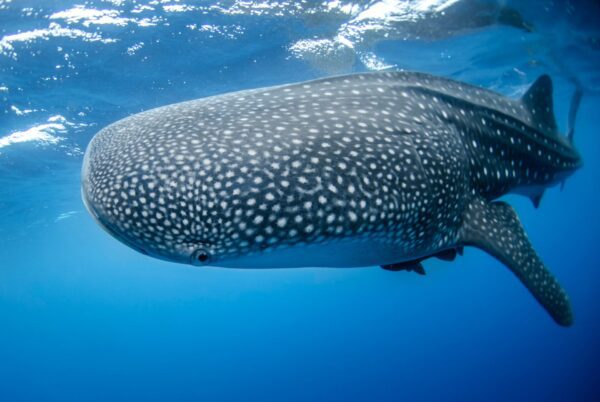
Fun fact about whale sharks: they have dermal denticles on their eyeballs. ⏐ Photo by NOAA on Unsplash
When an object is moving through water, eddies form along its surface. This causes drag and slows the object down. But if you create spaces for those naturally occurring eddies— and keep them separate from the rest of the flow— then you can reduce drag. This is how dermal denticles operate.
A whale shark’s eyes stick out from its head, kind of like that chihuahua your grandma used to have. But unlike that chihuahua, whale sharks are naturally occurring and use the denticles to protect their bulging peepers. As well as reducing drag, denticles are also a great protective covering (source)¹.
Are whale sharks aggressive?
Nope! They never attack people and are considered harmless. The most dangerous thing about whale sharks is their powerful tail. Beginner snorkelers will occasionally get in the way of a shark’s tail by mistake and get a good thwack (but no one has died from this).
Whale sharks also have tiny teeth, unlike their large-toothed cousins. These teeth are called rasp teeth, and whale sharks have thousands (source)⁵. Despite having more teeth than you could ever hope for, they don’t use them. Whale sharks suction water into their huge mouths and filter plankton through their gill rakers. No teeth necessary.
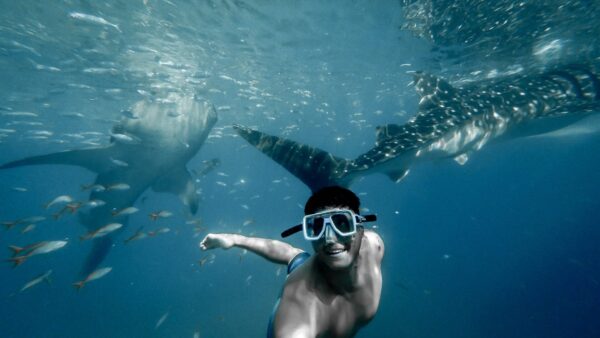
One fact about whale sharks is that they’re harmless, but you need to look out for their tails. This guy should watch where he’s swimming! ⏐Photo by Mike L on Unsplash
Why keep the rasp teeth then? To give some context on this fact about whale sharks, let’s talk about vestigial traits. These are traits that used to be important to an organism, and while they’re no longer needed, it’d take more energy to get rid of them than just leave it alone. One example is your coccyx or tailbone. Another example is your ticket stub from that time you saw Taylor Swift’s Eras Tour: it’s no longer useful, but you can’t bring yourself to throw it away.
Whale sharks have vestigial teeth from… well, something. There’s no evidence as to what their teeth used to be used for, but boy, do they still have ‘em.
Where do (whale shark) babies come from?
Scientists wish they knew this fact about whale sharks, but we just don’t have enough information on where the sharks go to give birth. They’ve been observed congregating around the South Atlantic Island of St. Helena, but mating, pupping, and potential nurseries are still a mystery. Only one pregnant whale shark has ever been studied after being caught in a net⁷.
To try to solve this mystery, scientists did an ultrasound on a free-swimming whale shark in the Galápagos. They wanted to confirm whether sharks in an area were pregnant, and to find out without killing them (another fact about whale sharks: they’re endangered!).
Imagine going for a morning jog when a group of people on scooters catch up to you, wave an ultrasound wand around your middle, then take a blood sample from your hand while you’re distracted. For the whale shark in the study, that’s how its day started.
This may seem like a bizarre data-collecting method, but think about all the whale sharks you’ve seen at the doctor’s office. Hopefully none, so I’m sure you can understand why they didn’t have the shark sit down for intake paperwork.
You can read more about the incredible whale shark ultrasound here⁷.
Like dogs, whale sharks have more than one uterus (yes, your dog has more than one). Unlike dogs, whale shark babies develop in an egg case inside the mother, hatch within her, and then they’re born. This is called ovoviviparity and it’s similar to live birth but with extra steps. “Ovoviviparity” is also a great word to use in Scrabble if you want to start a fight.
Are whale sharks whales or sharks?
Sharks! Normal whales need to breathe air to survive, but whale sharks, like their sharky cousins, need water constantly flowing over their gills to survive. They’re called whale sharks because of their whopping size. They can grow to about 12 meters long, or 39 feet (source)⁸. Another fact about whale sharks is that they’re the biggest sharks in the world, and the largest fish in the ocean.
Now, most people compare a whale shark’s length to the size of a school bus. But if you took 24 of Nudi Wear’s Unisex Sun Shirts and lined them up shoulder-to-shoulder, by golly, that’d be about the length of a whale shark! You can check out the shirts (which come in whale shark patterns) here.
What’s your favorite fact about whale sharks? Leave a comment below!
Sources:
- Frank, Z. (2023, June 21). True Facts: The Curious Adaptations of Sharks [Video]. YouTube. https://www.youtube.com/watch?v=0C2K9jvqtXs
- Martins, C., Knickle, C., Sigel, M., Bowling, T. (2020, January 20). Rhincodon Typus. Florida Museum. https://www.floridamuseum.ufl.edu/discover-fish/species-profiles/rhincodon-typus/#:~:text=It%20appears%20that%20these%20movements,tiger%20sharks%20(Ondontaspis%20taurus).
- Meekan, M. G., Fuiman, L. A., Davis, R. W., Berger, Y., & Thums, M. (2015). Swimming strategy and body plan of the world’s largest fish: implications for foraging efficiency and thermoregulation. Frontiers in Marine Science, 2. https://doi.org/10.3389/fmars.2015.00064
- Nakamura, I., Matsumoto, R., & Sato, K. (2020). Body temperature stability observed in the whale sharks, the world’s largest fish. The Journal of Experimental Biology. https://doi.org/10.1242/jeb.210286
- Norman, B. (2021, October 15). Whale Shark (Rhincodon typus). Australian Government⏐Department of Climate Change, Energy, the Environment, and Water. https://www.dcceew.gov.au/environment/marine/marine-species/sharks/whale-shark#:~:text=It%20is%2C%20at%20present%2C%20not,any%20location%20throughout%20their%20range.
- Pash, C. (2015, September 16). Science Reveals Why The Mysterious Whale Shark Gets So Big. https://www.sciencealert.com/science-reveals-why-the-mysterious-whale-shark-grew-to-be-so-giant
- Russell, Mark C. (2023, March 28). Whale shark reproductive ultrasound study published. Dive Magazine. https://divemagazine.com/scuba-diving-news/whale-shark-reproductive-ultrasound-study
- World Wildlife Fund. (n.d.). How big are whale sharks? And four other whale shark facts. WWF. Retrieved November 7, 2023 from https://www.worldwildlife.org/stories/how-big-are-whale-sharks-and-four-other-whale-shark-facts#:~:text=They’re%20not%20whales%2C%20but,to%20as%20%22gentle%20giants.%22



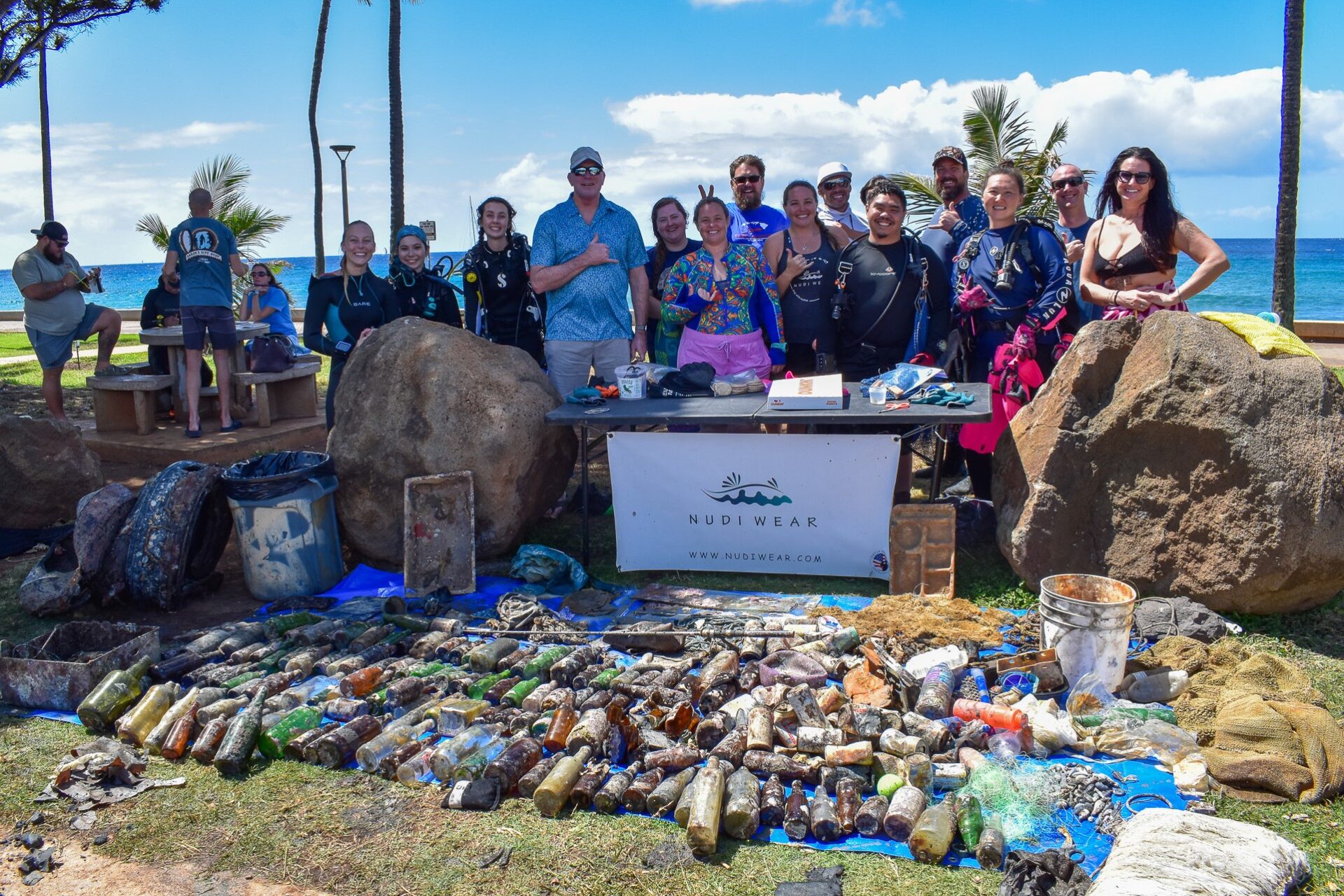



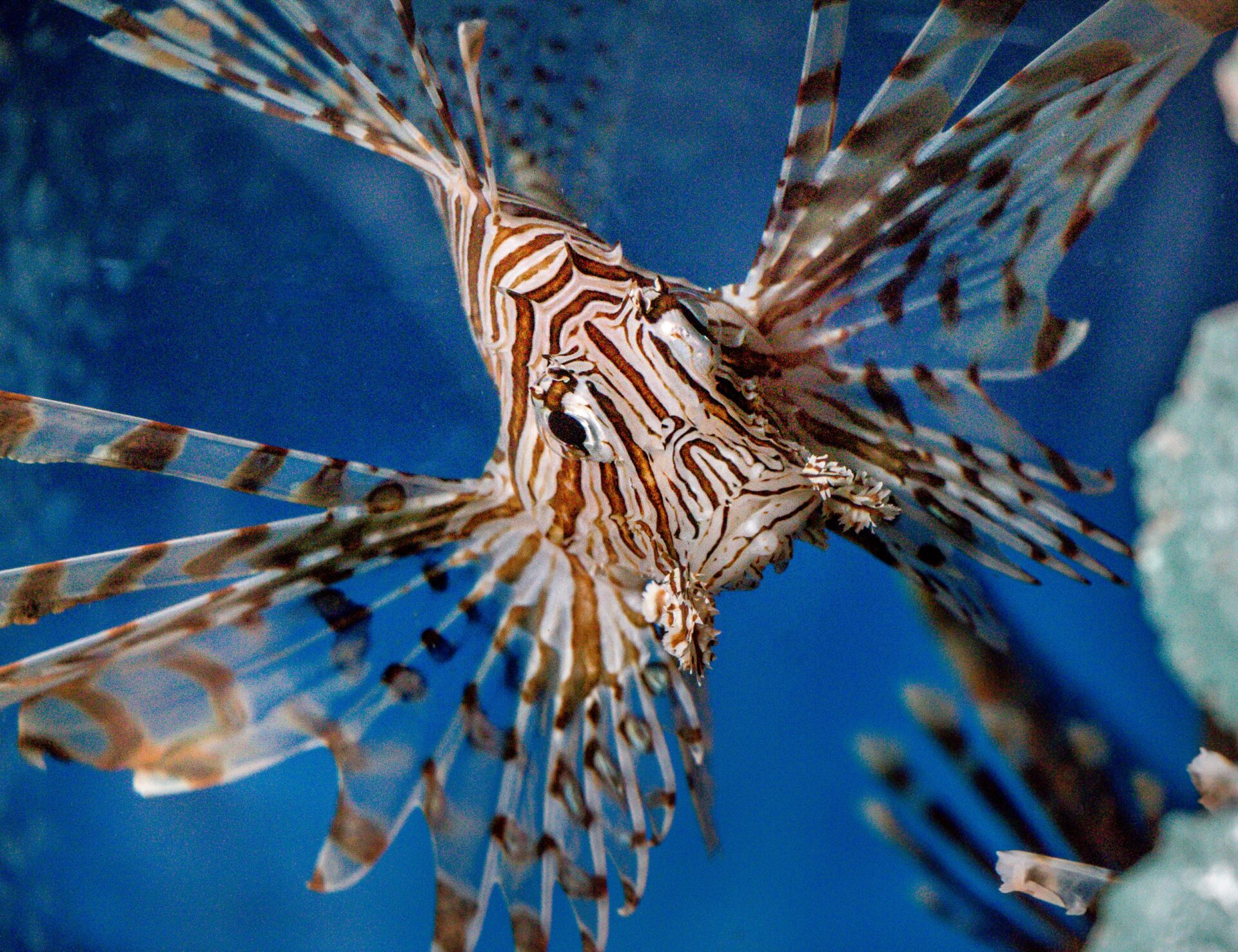
I think it’s crazy they have teeth but never use them!
I know, right? Thanks for reading!
Love a good shark fact
How crazy that we don’t know much about how they have babies 😮